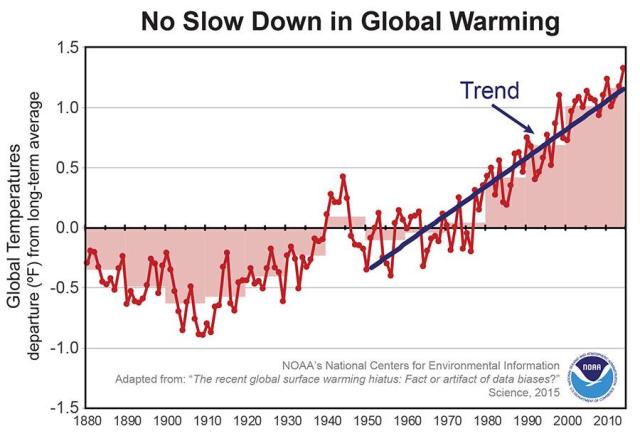Jun 17 2015
 Contrary to much recent discussion, the latest corrected analysis shows that the rate of global warming has continued, and there has been no slow down.
Contrary to much recent discussion, the latest corrected analysis shows that the rate of global warming has continued, and there has been no slow down.
A team of researchers from the National Centers for Environmental Information (NCEI) of National Oceanic and Atmospheric Administration (NOAA) and LMI has performed a study which revealed that the speed of global warming over the last 15 years of this century has been as fast, or even faster when compared to the rate seen over the last half of the 20th century.
The study, which has been published online in the journal Science, contradicts the idea that there has been a hiatus or slowdown in the rate of global warming over the past few years. The researchers used the new global surface temperature data to arrive at this conclusion.
Adding in the last two years of global surface temperature data and other improvements in the quality of the observed record provide evidence that contradict the notion of a hiatus in recent global warming trends.
Our new analysis suggests that the apparent hiatus may have been largely the result of limitations in past datasets, and that the rate of warming over the first 15 years of this century has, in fact, been as fast or faster than that seen over the last half of the 20th century.
Thomas R. Karl, LHD
Director, NOAA’s National Centers for Environmental Information
Hiatus refers to the perceptible reduction in the upward speed of global surface temperature warming. According to the Fifth Assessment Report of Intergovernmental Panel on Climate Change (IPCC) issued from September 2013 to November 2014, the trend of upward global surface temperature from 1998 through to 2012 was considerably lower when compared to the trend between 1951 and 2012.
Ever since the launch of the IPCC report, NOAA researchers have made major advancements in the computation of trends and are currently using a global surface temperature record, which contains the latest two years of information, 2013 and 2014. 2014 was the hottest year till date. In addition, the calculations utilize enhanced versions of land surface air temperature as well as sea surface temperature datasets.
A major enhancement is a rectification, which accounts for the variation in information acquired from ships and buoy-based data. Ships were used for measuring sea surface temperatures before the mid-1970s, and since then buoys were increasingly being used for this purpose. Also, buoys give more accurate measurements when compared to ships.
In regards to sea surface temperature, scientists have shown that across the board, data collected from buoys are cooler than ship-based data.
In order to accurately compare ship measurements and buoy measurements over the long-term, they need to be compatible.
Scientists have developed a method to correct the difference between ship and buoy measurements, and we are using this in our trend analysis.
Dr. Thomas C. Peterson
Study Author and Principal Scientist at NOAA’s National Centers for Environmental Information
Additional comprehensive data was collected about the observation method of individual ships. The same was utilized to provide enhanced corrections for alterations made in the combination of observing methods. Based on this data, new studies show that partial spatial coverage has also resulted in underestimating the actual global temperature change that was earlier specified in the 2013 IPCC report.
In fact, the combination of various datasets has enhanced spatial coverage across many regions such as the Arctic. Temperatures in such regions have been quickly rising over the past few years. For instance, the launch of the International Surface Temperature Initiative databank, together with NOAA’s Global Historical Climatology Network–Daily dataset as well as 40 more historical data sources has significantly increased the number of weather stations accessible for examination.
At length, the integration of two years of data (2013 and 2014) with 2014 being the hottest year till date has made a significant impact on the temperature change assessment. According to the IPCC, the hiatus period that spanned from 1998 to 2012 is rather short and started with an unconventional hot El Niño year, but over the entire record period from 1880 to till date, the recently quantified warming trend is not considerably different than that reported in the past [0.65°C per century (old) vs. 0.68°C per century (new)]. This reinforces the concept that the new, improved corrections mainly had a notable impact in recent years.